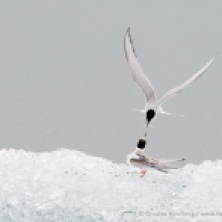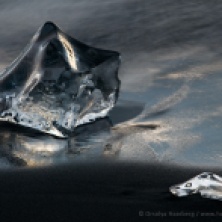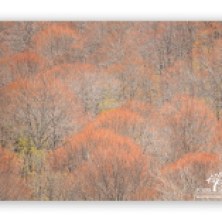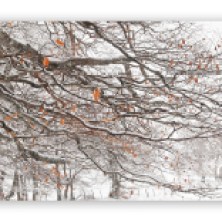Interview-Series: Orsolya Haarberg

Interview Orsolya Haarberg
by Kristel Schneider
‘ Nature is pure spirit, it is the biggest artist. If you want to document its art, you have to see Art in nature’

2014, a brand new year and new resolutions abound, as always, sometimes never to see the light. Therefore, after a whole year dedicated to private commissions, I decided that 2014 was the year to follow up a project I had started in 2011, when I regularly published interviews of nature photographers whose work had an impact on my way to take photos and meant something to me. The 2014 Interview-Series will be, as my father would always put it, “the same but totally different” in the way that they will bring out the female photographers that have really inspired me over the years, and still do. And photographers I got introduced to, more recently.
Like the 2011-series , the new project will feature the photographers who, each in their own personal and specific approach, can be seen as landmarks in the world of nature photography.
The first one who nicely accepted to be part of the “Interview-Series” is Orsolya Haarberg, whose work I got introduced with, while browsing the results and prizes of the GDT European Wildlife Photographer of the Year 2011. Back then, she got highly commended, in the “Plants” category, for a very strong graphical image picturing seaweed. Since then I have followed her work and she has definitely inspired me a lot in looking at the tiny details of the world around me.
1 Q: Can you introduce yourself in a few lines, explain your background and how you got introduced to (nature) photography?
I was born in Hungary in 1977. Graduated as landscape architect and started my PhD studies in wildlife management before I turned full-time nature photographer at the age of 28. My mother played an important part in why nature photography became my hobby in the late ‘90s. I was drawing and painting a lot because of my studies, and she thought I might be interested in photography as well. She got her brother’s used Minolta camera for me – this is when my photographer career began…
2 Q: Your projects usually take place in the North Cape area. What originally triggered your interest for this region? In the beginning I did nature photography in my home country, and I never thought that photography could become my profession – in Hungary you cannot make a living from image sale as a nature photographer. I travelled to Norway because of my PhD studies – this is how I met Erlend Haarberg, my husband. He had already been an established nature photographer at that time and we thought we would try to make a living as freelance nature photographers together. We gave ourselves 3 years to try if it worked. This has happened 8 years ago, and we do better than ever
In Norway you can sell images mostly about Norway, so it makes sense for us to focus on photographing Norwegian landscapes and wildlife. On the other hand, Norway is a dream for a nature photographer. You can find wild landscapes, interesting wildlife, and you can move and work freely in the country. I really appreciate this as I grew up in Hungary, where you are much more limited in entering and photographing either state-owned protected areas or private lands.
But you are right – I am most interested in photographing the northernmost regions of Norway. I love open scenes, where the Earth meets the sky on the horizon: the sea and the barren landscapes. I also like snow-covered landscapes, and the long winters in the north give plentiful opportunities to photograph in such conditions.
3Q: In 2012 National Geographic Magazine sent you and Erlend Haarberg on an assignment to photograph the unique coast of Norway.
Can you tell the readers how you prepared yourself for such an assignment and how you organized it all? I mean, how do you spread the work between you two ; do you mainly focus on the subjects you like the most then,as individuals, or do you really work as a team on all the subjects? I often see publications under your both names, do you also work on assignments on your own?
We work as a team, which means that we usually have common projects and most of the time we travel together, but we work on our own. We like each others company a lot, we inspire and support each other, and traveling together reduces our travel expenses. When we arrive to a location where we want to work a longer period, we explore the area separately and find different topics to photograph. It may also happen that we photograph at the same spot because one single topic has the best potential, but even then we do not return with the same images. So our work is complementary.
When you see publications credited to both of us (like in NGM), it means that the article contains images that are both Erlend’s and mine.
Regarding the Norway story, we had a list of places to photograph. In case we had several potential topics to photograph at a certain time of the year (like in the best autumn weeks), we split up and traveled alone.

4Q: When I look at your images my personal favorites are the intimate landscapes with beautiful details. You have a way of capturing structures and details from a landscape that will be overlooked by many people. Do you think a person must have a feeling for art or graphics to translate the landscape scene into an intimate image?
Nature is pure spirit, it is the biggest artist. If you want to document its art, yes, you have to see Art in nature. You must have the ability to see a level of harmony in chaos. I spend a lot of time in nature to find new and interesting subjects, and once something catches my eye I do not stop until the captured image is balanced, the scene is simplified to its essence and keeps surprising me even after looking at it again and again.
5Q: What are your personal photography goals for 2014 and what would you like to achieve in photography in the long term?
I would like to always have the freedom to discover landscape and wildlife that I can transform into good images. And I would like to continue working on well-defined long term projects. This is my personal goal for 2014 and in the long term.
6Q Can you share with us some of your personal photographs you like best?
And can tell us about the conditions and your emotions when you captured this image.
I would like to share a landscape photograph as one of my personal favorites. I like it when a landscape image is complex and when several things are going on at the same time. Apart from an interesting scene, good – mostly natural – light and good composition, you also need a little extra that makes the image unrepeatable… It is difficult, and digital revolution did not help at all to make it easier.
Therefore I would like to share the story of my image about the Hverfjall crater, which is a very good example to show you the challenges in landscape photography.

Hverfjall in Iceland is a well-known landmark that is rather difficult to photograph. The beautiful shape of the crater is visible from a certain direction only, and as there are villages, farm houses and electric lines close to the volcano, it is better to photograph it from a distance. I finally found the right angle, but a lot of other things needed to be fulfilled.
First of all, the beautiful structure of the outer slopes of the crater is visible only when it is covered by a thin layer of snow. In January and February 2011, there were no such conditions, winter set in in the middle of March.
If I wanted to photograph the crater with the Moon, I needed the Moon rising at the right place, which narrowed down my possibilities to a single day in 2011: the 18th of March. A clear day, of course, otherwise the Moon was not visible.
And I needed a foreground. There was a thin layer of ice on lake Myvatn, but it wasn’t really interesting enough, so the question of the foreground was still open when I left my base to take the image I wanted. It was overcast, but I was optimistic…
And when I arrived to the spot I had previously chosen, the wind rose and quickly blew the clouds away. At some places, the ice covering the lake was so thin, that the wind broke it and water could reach the surface of the ice through some hair-thin holes. The water captured the snow which was carried away by the strong wind during the hours I was taking photos. The white stripes of snow on the foreground literally built up before my eyes during the time span of one or two hours!
I had to leave quickly after I took the image, because right behind me there was a wall of snow blown by the storm, and I had a one-hour ski-trip crossing half-frozen lakes in the darkness, back to the car. It was a truly memorable moment…
7Q Do you have any exhibitions or other events coming up ?
In March 2014 I will have an exhibition and a picture show at the Norwegian Nature Photo Festival in Ski and another lecture in Sweden one week earlier.
I try not to commit myself to too many events before late October (a peak in the festival season) so that I have enough freedom to do my planned field work when conditions are best.

Orsolya had a look at Kristel’s website (http://www.kristelschneiderphotography.com) and picked out some images that really popped out for her. She explains why.
Most of these images were taken during the transition from autumn to winter or from winter to spring which are very exciting times for photography. In these periods it is not the green colours that dominate the landscape but different shades of grey vivified by some yellows from the late autumn or early spring days. These low-key colours are very pleasant for my eyes. I also found the subject and the composition very interesting on all the selected photographs.
Orsolya’s picks from Kristel’s images:
Coming up next, in the “Interview-Series” : Alessandra Meniconzi, don’t miss it!
 Visions and Nature
Visions and Nature 














Pingback: Interview-Series: Orsolya Haarberg | visionsandnature
Comment via Linkedin
Dudley Danielson
Photography Professional
I’ve already added my profound feelings to this interview at the bottom of her page. But you, Kristel and she (Orsolya), have triggered my inner man to see and feel what the Master Creator has crafted. The Word says: “Open my eyes that I may see.” Today that has happened again and I am happy. Now, to walk softly so I can discover the precious beauty that awaits my brush strokes as I press the shutter in anticipation. Thank you both. Blessings